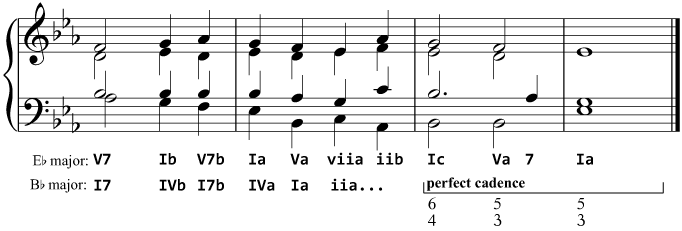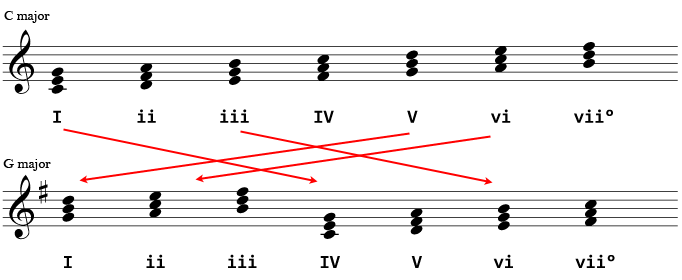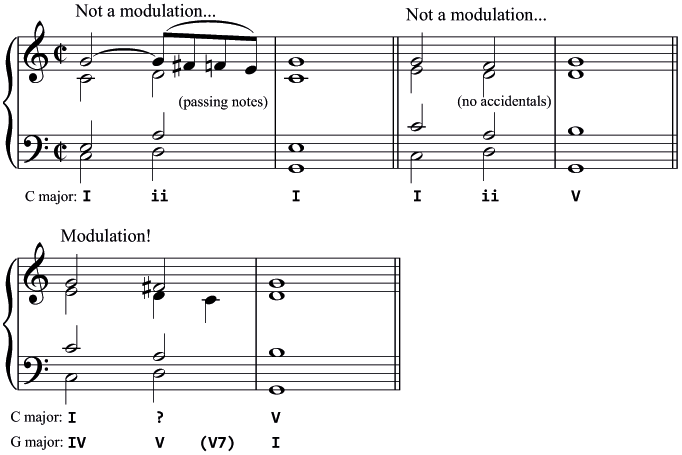Modulation
In this guide...
Key terms:
Subscription required!
To view the complete study guide, you will need a valid subscription. Why not subscribe now?
Already have a subscription? Make sure you login first!
Introduction
We now about lots of different triads and other chords as well as the functions of different chords in a key. We now consider how to use chords to move between different keys.
Identifying the key
Prior to reading this study guide, make sure that you are quite confident with identifying the key of a piece of music. We have covered this topic in Identifying the key.
Changing key
A piece of music does not have to remain in one key. It can make a plain piece of music come to life if the music changes key, and add a great deal of interest.
This is not a technique only found in classical music - it is quite common for the chorus in a song to change key, for example. Try listening to Michael Jackson's The Man in the Mirror, in which (mid-way through the song) he employs a very clear key change, on the word "change", no less!
We use the term modulation to mean "a key change". If we are "modulating", we are "changing key", and if a piece of music has changed key by a certain point, it has "modulated" by that point.
The hymn tune Abide with me changes key at the end of the passage below:
 In Abide with me the music changes key from E flat to B flat major
In Abide with me the music changes key from E flat to B flat majorAlthough only the melody is shown, we can still see the key change at bars 7-8. To illustrate this, consider how you would harmonise the cadence (which we looked at in detail in Harmonising a cadence).
What cadences work at that point? Let's consider the options, given that we are (apparently) in E flat major...
- Perfect cadence (
V-I) - no, the A natural does not fit - Plagal cadence (
IV-I) - no, the A natural definitely does not fit - Imperfect cadence (ending on
V) - yes, maybe; ending onVis possible, but preceded by what?
As no triad in the scale of E flat major will harmonise the A natural, we can instead look at what we would do if, temporarily, we say that the key is instead B flat major.
In this case, we can easily select a perfect cadence, V-I, because V in B flat major has an A natural. We could even use V7 for added effect, to emphasise B flat major.
To further emphasise this key change from E flat major (in which the music has clearly been thus far), we want to select an approach chord that will suit both keys. The obvious candidate is I in E flat major, which is IV in B flat major. That will turn the cadence into the very common IV-V-I in B flat major.
Here is the relevant section of the music again, with triads and analysis added:
 Triads harmonising the key change in Abide with me
Triads harmonising the key change in Abide with meJust to complicate matters somewhat: if you have seen the standard harmonisation of this hymn in a hymn-book, you will see that rather than V7 in B flat major, the composer uses the substitute triad vii°, as discussed in Diminished triads.
Here is the composer's own harmonisation of this cadence:
 W.H. Monk's harmonisation of the key change in Abide with me
W.H. Monk's harmonisation of the key change in Abide with meBy bar 9, the composer has successfully modulated to the dominant, and we can re-interpret all the harmony which follows in the context of a "new" tonic: B flat major.
Changing back again
Having changed key in (as in our example, Abide with me), it is a good idea to change back to the original key, as music will usually sound more complete and satisfying if it ends in the same key as it begins. This is especially true of a hymn tune which has to be repeated over and over for different verses!
A simple way to change the key back again is to simply use a dominant seventh in the target key, resolving to the tonic in the target key, for a V7-I perfect cadence. This is exactly what happens in Abide with me for the final phrase. Here is the composer's own harmonisation, to return to the original tonic of E flat major:
 W.H. Monk's harmonisation of the key change back to the tonic in Abide with me
W.H. Monk's harmonisation of the key change back to the tonic in Abide with meNotice that, to reinforce the fact that the music has returned to the tonic (E flat major), the composer uses the very strong 64 - 53 form of approach to the final perfect cadence.
Key changes and modulations
Note that it is not necessary to introduce a new key signature after a modulation.
A modulation is often (as in Abide with me, above) a temporary change to a different key, and so normally we make do with the use of accidentals where necessary, rather than actually changing the key signature.
Of course, if the purpose of the modulation is to permanently change key, then it is definitely a good idea to use a new key signature!
Pivot chords
Modulation is often achieved by using a chord which belongs to both the original and the new harmonic contexts, as in our example above: in the key change from the dominant back to the tonic, the composer uses V in E flat major (which is I in B flat major) to construct a perfect cadence in the target key.
A chord that belongs in both the current and target keys is called a pivot chord and is a very useful technique in modulation.
Look at the triads of C major and G major:
 Identical triads in C major and G major
Identical triads in C major and G majorYou can see that four of the seven triads in C major are also present in G major. This gives four opportunities for a modulation to the dominant (if we start in C major and modulate to G major) and back again (from G major to C major).
Common modulations
As you can see above, there are many opportunities to modulate to the dominant. This is in fact a very common modulation, one that you are likely to see in an exam question asking you to identify a modulation.
The ease of modulation to the dominant is primarily because the key signatures are very similar: only one note is different (G major has F sharp, C major has F natural, for example).
It is therefore equally easy to modulate to the subdominant, for example to modulate to C major from G major. This is, in fact, just the reverse process of modulating to the dominant, and is therefore necessary in order to return back to the original key.
Relative keys
What other keys have many notes in common?
As you know, every key signature can be used in two keys: a major key and the relative minor key - for example, G major and E minor share the same key signature, of one sharp.
This, therefore, presents an opportunity for easy modulation from one key, to the relative minor (or major), then back again, using pivot chords.
A modulation to the relative minor is quite easy to accomplish using ii in the major key as a pivot chord to set up a IV-V-I cadence in the relative minor key, as shown here in a modulation from C major to A minor:
 A modulation to the relative minor using
A modulation to the relative minor using ii as a pivot chordii is a pivot chord in this example because it serves as ii in C major, and as iv in A minor.
Leading note
The 7th degree of the scale, known as the leading note, is vital to any successful modulation. Without using a leading note, it can be quite unclear what the key is.
For example, when modulating from C major to the dominant (G major), if you do not use F sharp (the leading note of G major), then it will never be clear that a modulation has taken place, because F sharp is the only difference between the notes in G major and C major.
How to identify a modulation
While you will not be expected to write a modulation in a music theory exam at this level, you are likely to be asked to recognise that one has taken place in a written example, and to identify the relationship between the two keys.
The common form of this type of question asks you to identify either the key or the degree (e.g., dominant) to which the music has modulated by a certain point.
To identify a modulation, follow these two suggestions:
- Look for accidentals
- Look at the bass and the cadences
Look for accidentals
Accidentals are a clear sign of a modulation, as it is almost impossible to modulate from one key to another without using them.
The accidentals introduced will indicate the identity of the new key. In particular, look for an accidental for the leading note in the new key. In Abide with me, above, the A natural accidental was required to create the leading note (7th degree) in the new key of B flat major.
Warning!
Accidentals frequently appear in music which does not modulate, so the simple observation of accidentals is not enough by itself to say that a modulation has definitely taken place.
However, if a modulation has taken place, then accidentals will be present.
Always double check by testing your idea against the facts. If you think a modulation from B flat major into F major has taken place, for example, look for E naturals. If there are E flats present in the music soon after you think the modulation has taken place, then you are either wrong about the new key, or about the modulation in the first place.
Look at the bass and the cadences
Remember what you have learnt about cadences. Look at the end of the phrase at the point in the music where you suspect a modulation. Try to identify what the cadence might be, particularly using the bass motion. This will very likely reveal to you what the new key is.
The bass notes can be the clearest signs of this. A rising 4th, or a falling 5th in the bass at the end of a section is very likely to indicate a perfect cadence in the new key, especially when accidentals are involved.
Warning!
This is not a fail-safe method on its own. For instance, the bass motion from iia to Va is also a rising 4th, or a falling 5th, yet that could just be an imperfect cadence in the tonic. So, check your accidentals too!
Given both of these warnings, it should be clear that you should never rely on just one or other suggestion, but using both correctly together will help solve the puzzle.
For example, in C major, ii contains the notes D, F, A and V contains G, B, D. If, however, the F in ii was an (accidental) F sharp, this would clearly be V-I in the dominant (G major), and not ii-V in the tonic (C major).
The difference is illustrated here:
 The first two examples are not modulations, but the third example is a modulation
The first two examples are not modulations, but the third example is a modulationRead more...
With a subscription to Clements Theory you'll be able to read this and dozens of other study guides, along with thousands of practice questions and more! Why not subscribe now?